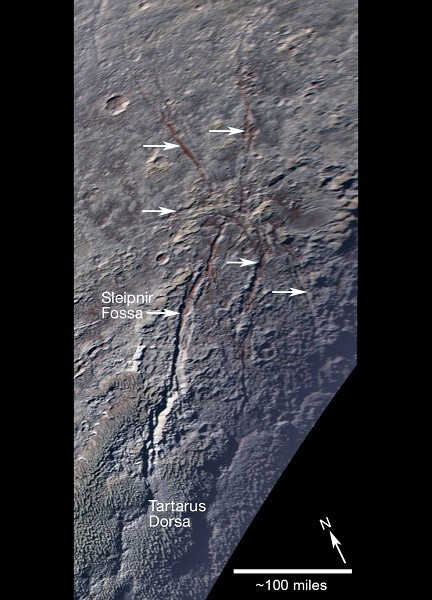By Ana Verayo, | April 10, 2016

Pluto’s unusual spider-like feature consists of at least six extensional fractures that converge to a point. Individual fractures can reach hundreds of miles long and appear to expose a reddish subsurface layer.
Scientists captured one of the most intriguing landscape features on Pluto which appears to be sprawled on the surface of the dwarf planet like a gigantic spider via NASA's New Horizons mission.
According to New Horizons geology scientist, Oliver White, from the NASA Ames Research Center in California, Pluto can weave a geological tangled web, which reveals an unprecedented fractured pattern that has never been seen before in the outer solar system. This only proves how complex Pluto's surface and terrain, revealing distinct features in any region of the dwarf planet.
Like Us on Facebook
Using the onboard camera of New Horizons' Ralph/Multispectral Visible Imaging Camera (MVIC), this image was taken from 21,000 miles from the surface of Pluto at a resolution of 2,230 feet per pixel, some 45 minutes before New Horizons' closest approach on Pluto last year.
The enhanced color image of this icy web on the surface of Pluto was taken by the New Horizons spacecraft last July 14, 2015. The feature can be described as possessing at least six extended fractures where the longest of them is known as Sleipnir Fossa that is measured at 360 miles long. The fracture can be observed to be aligned in such a way that from east the west is measured at less than 60 miles.
From the northern region to the west of the fracture, they are extended across the pockmarked, icy plains located in the higher north latitudes. In the southern region, they are intersected and overlapped by jagged terrain features known as Tartarus Dorsa. This stunning image also reveal the interior of the planet, as the spider's legs expose some reddish deposits underneath the surface.
Mission scientists of New Horizons believe that these fractures can be discovered in different parts of Pluto since they have the tendency to run across parallel with one another in massive belts that are caused by a global scale extension of the planet's water ice crust.
However, this distinct spider pattern that can be seen radiating outside the surface could ink to a geological stress point underneath the crust where all the fractures meet at single point, which can also mean that some sort of material is welling up from under the icy crust.
Scientists also say that the fractured centers of this spider pattern on Pluto could resemble the fractured centers on Venus known as novae, which have been observed by NASA's Magellan spacecraft, including the Pantheon Fossae formation on Mercury that has been recorded by NASA's MESSENGER spacecraft.
-
Use of Coronavirus Pandemic Drones Raises Privacy Concerns: Drones Spread Fear, Local Officials Say

-
Coronavirus Hampers The Delivery Of Lockheed Martin F-35 Stealth Fighters For 2020

-
Instagram Speeds Up Plans to Add Account Memorialization Feature Due to COVID-19 Deaths

-
NASA: Perseverance Plans to Bring 'Mars Rock' to Earth in 2031

-
600 Dead And 3,000 In The Hospital as Iranians Believed Drinking High-Concentrations of Alcohol Can Cure The Coronavirus

-
600 Dead And 3,000 In The Hospital as Iranians Believed Drinking High-Concentrations of Alcohol Can Cure The Coronavirus

-
COVID-19: Doctors, Nurses Use Virtual Reality to Learn New Skills in Treating Coronavirus Patients







